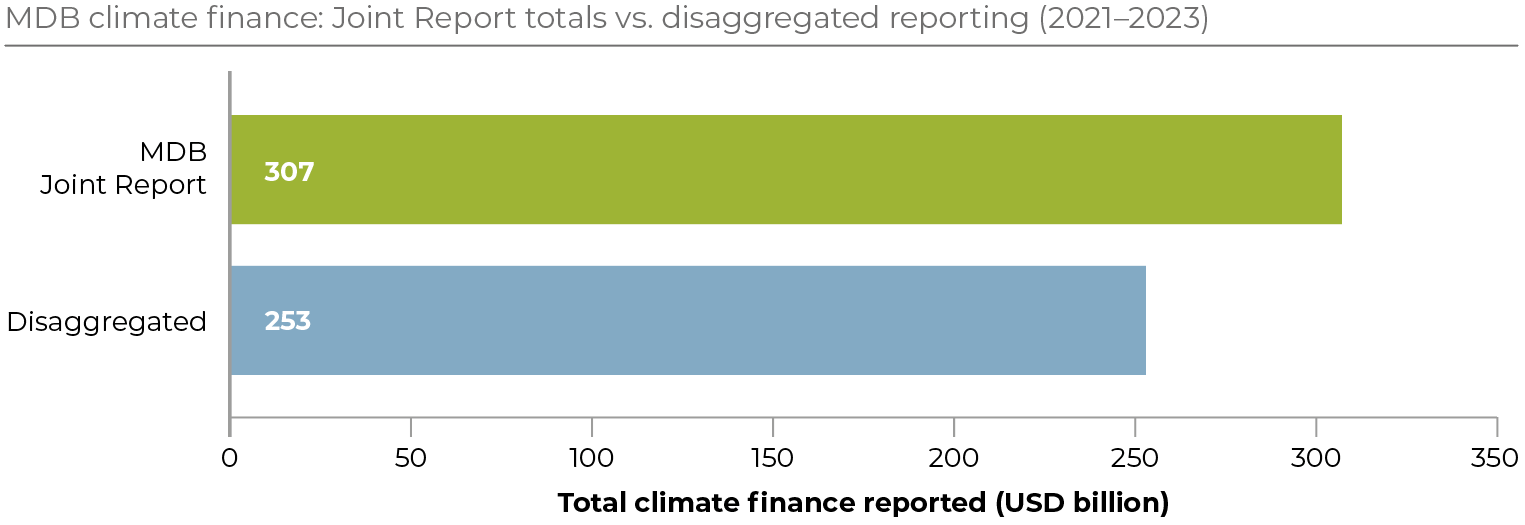MDB Climate Finance Dataset
Multilateral development banks (MDBs) are central actors in the global effort to scale up climate finance. By 2030, MDBs estimate that their sovereign and non-sovereign portfolios will deliver US$120bn in climate finance each year to low- and middle-income countries. MDBs report headline figures in their Joint Report on Climate Finance (Joint Report): in 2024, they committed US$85.1bn for low- and middle-income economies, compared with US$74.7bn, US$60.9bn and US$50.7bn in 2023, 2022 and 2021 respectively.
At present, behind these headline numbers lies a persistent problem for some MDBs: the lack of systematic, investment-level disclosure. Without complete and accessible project-level data, it is difficult for stakeholders to verify aggregate claims, assess alignment with country priorities, or understand which sectors, regions, and instruments are receiving climate finance. The 2025 DFI Transparency Index highlighted this gap, finding that while several development finance institutions (DFIs), including MDBs, now publish methodologies for counting climate finance, only some disclose consistent project-level data.
The dataset
In November 2025, we compiled all publicly available investment-level climate finance data from eleven MDBs into a single, centralised dataset covering 2021 to 2023. While we sought data from all eleven institutions, investment-level data was available for only six MDBs, which we have compiled here. The main purposes of this dataset are to:
- Offer stakeholders a compiled and accessible dataset for data analysis
- Highlight the gaps in MDB reporting
- Offer a benchmark for what meaningful disclosure looks like
- Act as a starting point towards full, standardised disclosure of climate finance at the investment level
The dataset provides the first cross-MDB view of investment-level climate finance disclosure. It examines the climate finance disclosure practices of the eleven MDBs that contribute to the annual Joint Report:
- African Development Bank (AfDB)
- Asian Development Bank (AsDB)
- Asian Infrastructure Investment Bank (AIIB)
- Council of Europe Development Bank (CEB)
- European Bank for Reconstruction and Development (EBRD)
- European Investment Bank (EIB)
- Inter-American Development Bank (IDB)
- IDB Invest
- Islamic Development Bank (IsDB)
- New Development Bank (NDB)
- World Bank Group (WBG) – IBRD/IDA, MIGA and IFC
The file includes two tabs with distinct purposes:
- Source dataset: containing only the information directly disclosed by MDBs in the original sources from which we extracted their project-level data.
- Enriched dataset: a more complete version where we have standardised, edited and, where necessary, supplemented the raw data with information from other MDB sources to fill gaps and improve comparability. This version aims to make the dataset as useful as possible to stakeholders.
Our full methodology is available here.
Behind the billions
Our accompanying report, Behind the Billions: tracking the missing pieces of MDB climate finance data sets out how we compiled the dataset, and what we can learn from the data – and the gaps.
The dataset identifies 4,691 unique investments across 2021, 2022 and 2023 amounting to a total of US$253bn in individual public climate finance investments for the MDBs included. This means that US$54bn of the climate finance reported in the Joint Report over the same period is untraceable, underscoring a discrepancy between the aggregate figures MDBs publish jointly and the disaggregated data they disclose individually.

Key findings include:
- Only six (AIIB, AsDB, EBRD, EIB, IDB and WBG) have a dedicated source of investment-level climate finance data.
- Just two (AsDB and IDB) publish complete, machine-readable datasets aligned with their aggregate totals for all three years.
- The World Bank publishes near complete data, but IFC and MIGA remain opaque.
- Evidence from AsDB, IDB, EBRD, EIB and AIIB shows that even private sector climate finance can be disclosed without breaching confidentiality.
Recommendations
The remaining MDBs must move beyond aggregate reporting and publish full, investment-level climate finance data that is both accessible and comprehensive. Without this, stakeholders cannot verify the billions reported in annual totals, nor assess how and where climate finance is being delivered. The disclosure of both sovereign and non-sovereign investment data by institutions such as IDB and AsDB demonstrates that comprehensive, project-level reporting is feasible. This indicates that barriers to disclosure may be lower than often assumed, and other MDBs should follow this example.
Next steps
With additional time and resources, we would like to strengthen the dataset by continuing to standardise fields across institutions, including sector and investment instrument. We would also like to incorporate further fields used in the Joint Reports such as country income level. These steps would make the dataset more comprehensive and user-friendly.
Once the 2024 interactive climate finance data dashboard is released, we would like to incorporate the 2024 data into future additions to this work. This will allow us to track how MDB disclosure evolves in response to the new platform and assess whether it addresses the key transparency gaps identified in this report.

